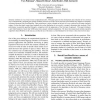Free Online Productivity Tools
i2Speak
i2Symbol
i2OCR
iTex2Img
iWeb2Print
iWeb2Shot
i2Type
iPdf2Split
iPdf2Merge
i2Bopomofo
i2Arabic
i2Style
i2Image
i2PDF
iLatex2Rtf
Sci2ools
LREC
2008
2008
The Construction and Evaluation of Word Space Models
Semantic similarity is a key issue in many computational tasks. This paper goes into the development and evaluation of two common ways of automatically calculating the semantic similarity between two words. On the one hand, such methods may depend on a manually constructed thesaurus like (Euro)WordNet. Their performance is often evaluated on the basis of a very restricted set of human similarity ratings. On the other hand, corpus-based methods rely on the distribution of two words in a corpus to determine their similarity. Their performance is generally quantified through a comparison with the judgements of the first type of approach. This paper introduces a new Gold Standard of more than 5,000 human intra-category similarity judgements. We show that corpus-based methods regularly outperform (Euro)WordNet on this data set, and that the use of the latter as a Gold Standard for the former, is thus often far from ideal.
| Added | 29 Oct 2010 |
| Updated | 29 Oct 2010 |
| Type | Conference |
| Year | 2008 |
| Where | LREC |
| Authors | Yves Peirsman, Simon De Deyne, Kris Heylen, Dirk Geeraerts |
Comments (0)

